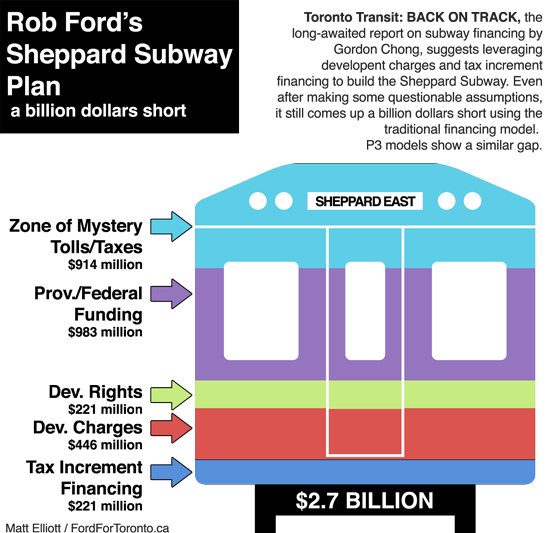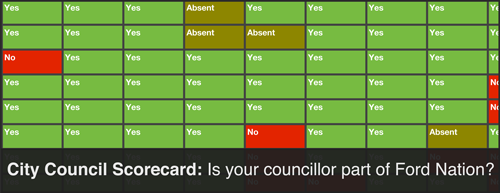From way back in November, when Rob Ford first unveiled what he has been calling a “smart, reasonable and responsible” budget, as reported by the Globe & Mail’s Patrick White, Elizabeth Church and Tu Thanh Ha:
“For the first time ever, folks, we will spend less next year than we did this year,†Mr. Ford said during a morning press conference. “That is unheard of.â€
…
Budget chief Mike Del Grande hailed the document, telling the budget committee: “It’s too bad the rest of the world doesn’t have the courage to do what we are doing today.â€
via Ford’s 2012 Toronto budget includes hikes in property tax, transit fares | Globe & Mail.
But that was then. This is now.
With council set to meet tomorrow to kick off what will probably be a three-day-long budget debate — packed with yelling and screaming and wild accusations of extremist political ideology — the piece I’m watching most closely is whether the mayor emerges from the fray with that key talking point in his jacket pocket: after all is said and done, will the 2012 gross operating budget actually be smaller than the 2011 budget?
Early indications say maybe not. At the beginning of this process, Ford’s gross budget was a slim $50 million below the 2011 level. Earlier this month, approximately $2.5 million was added to that budget to stave off cuts to community centres and student nutrition programs. Another $3 million was added at executive committee to reduce the number of requested cuts to the Toronto Public Library, joined by $1 million to save sidewalk snow clearing in the suburbs and $2 million to preserve some community grants. Other assorted tweaks also increased the total.
All told, the margin between the 2011 and 2012 budgets is down to about $41 million.
And now, via the Globe & Mail’s Patrick White, we learn that members of council’s opposition along with several middle-aligned councillors have been working on a plan that could inject anywhere between $20 million and $40 million back into the operating budget to preserve services:
While the core of the Ford budget remains intact – $350-million in cuts and efficiencies, a 2.5-per-cent tax, increase, nearly 1,200 layoffs – members of City Hall’s centre and left factions have been plotting for weeks about whether they’ll support the budget and, if not, how they’ll unravel it.
Many have been using Google Docs online to analyze and share strategies for portions of Mr. Ford’s budget that remain in play: TTC route cuts, reductions to community grants, terminated swimming-pool funding, three homeless shelter closings, a trim to priority centres and a cancelled leaf-collection program in Etobicoke.
One plan from middle councillors would stave off most of those cuts $20-million cost. Left-leaning councillors want to go even further with a plan to undo about $40-million worth of the mayor’s budget, according to several councillors speaking on background.
via Mayor’s team scrambles as moment of truth approaches | Globe & Mail.
So council may just go and overrule the mayor’s spending priorities to the tune of $40 million. Not only would that be unprecedented, but that kind of outcome would threaten to push Ford’s reputation away from what he most wants to be: a hardline budget buster. Instead of cutting back on overall city spending, he’d be the mayor who has essentially maintained spending levels set by his predecessor and the previous council. The people he derides as socialists.
The Revenue Game
Deputy Mayor Doug Holyday has told the Toronto Sun that he plans to ask council to approve next year’s property tax rates early on during tomorrow’s meeting, to avoid games later on where councillors might seek to slightly increase rates to preserve certain services. Councillor Gord Perks tried something like that last year, when he moved an amendment that would have increased residential property taxes by 0.155% to preserve bus routes and other programs. (It didn’t pass.)
With a prior-year surplus that will total almost $200 million when all figures are calculated, I don’t see councillors looking to the property tax base to preserve programs and services. Nor do I see them messing with staff revenue projections. Instead, all eyes will be on that surplus. It’s ripe for the taking and, despite claims to the contrary, hefty enough that it can serve double duty as a life preserver for programs and a capital debt killer.
As this strategy has gained steam, opponents have been pulling out lame household budget analogies to  caution against applying any of the surplus toward operating costs. The Globe’s Marcus Gee characterized the move as “like relying on sofa-cushion money to pay the mortgage.” Councillor Doug Ford said it would be like using a Christmas bonus to buy toys “like a drunken sailor.” (Sailors, as we all know, love toys.)
None of these analogies work, of course. Calling the 2011 surplus “one-time money” is disingenuous, because the city has seen continued surpluses going back at least six years. This year’s surplus was widely expected by everyone who rightly scoffed at the mayor’s scare-tactic figure of $774 million. And if someone was finding money in their sofa cushions as regularly as the city finds year-end surpluses, they would really  need to take a good look at what the hell is going on with their couch.
When it comes to the surplus, the real question can’t be boiled down to some oversimplified household budget analogy. What councillors have to consider is this: does the near-term value of preserving services (like transit) outweigh the long-term value of paying down debt on capital purchases slightly faster?
Budget Ideology
Let’s end with this: last week, the Toronto Star’s David Rider reported on a recorded conversation Budget Chief Mike Del Grande had with a constituent this past summer. In it, Del Grande reflects on some of the thinking that apparently shaped this budget:
Del Grande defended a proposed $400,000 cut to student breakfast programs — he recently and unexpectedly started to oppose the cut — during an hour-long, Aug. 10 city hall chat with then-constituent Hakim Kassam, who recorded it on his iPhone.
“I don’t support the way that’s funded because if we’re going to do breakfast in schools, to me personally, if you have children you’re responsible for children,†Del Grande said in the recording provided by Kassam to the Star.
“The nation is not supposed to be in the bedrooms of the people. But then when you come out of the bedroom and you have children, why is it the state’s responsibility to look after your children? I didn’t tell you to wear a condom or not wear a condom or how many children — you made that decision.â€
via Toronto budget: Mike Del Grande’s candid chat about social programs | Toronto Star.
Kind of puts all that “radical conservative” talk in perspective, doesn’t it?
I don’t think what Rob Ford ultimately presented as his budget is a purely ideological document, but I do think it was informed by the kind of ideological thinking Del Grande talks about in the recorded conversation. But that ideology was tempered by the mayor’s famous populism and a political reality that demands certain services be kept. The end result is a fiscal stew: a cobbled together collection of arbitrary cuts and decisions.
Indeed, the budget’s greatest failing is that it lacks any kind of unifying purpose. There is nothing in these pages that reveal a coherent theme for this city going forward. There’s no indication of what our collective priorities are — are we a city that values transit? The environment? Revitalized neighbourhoods? A better business climate?
Who can say? There’s very little in this budget that tells us what kind of city we actually want to be.





